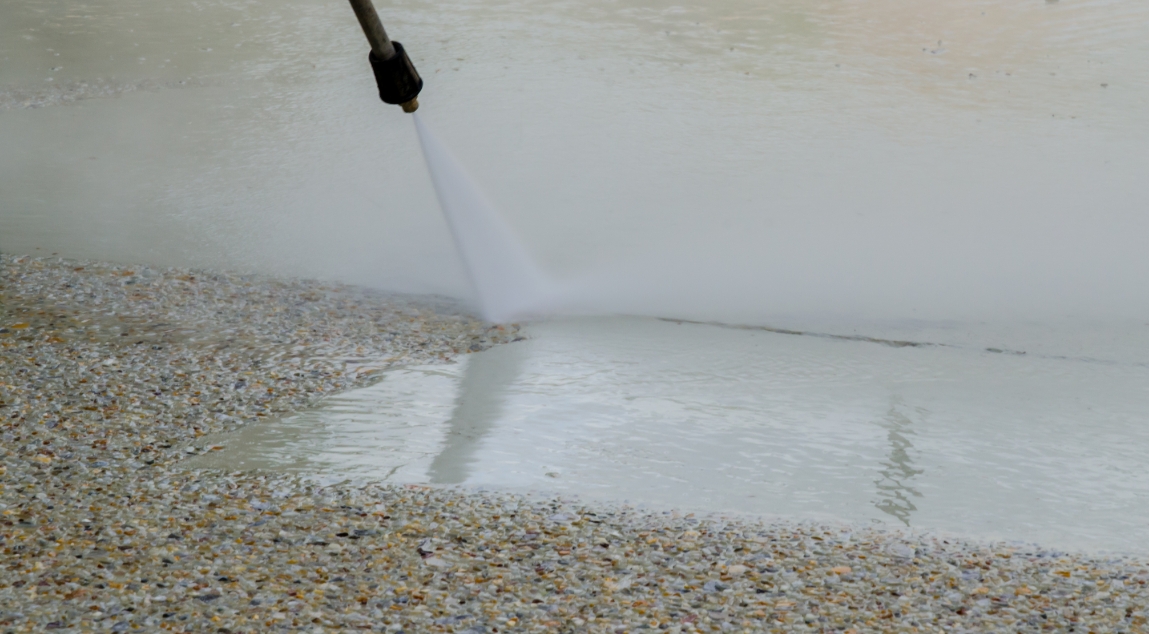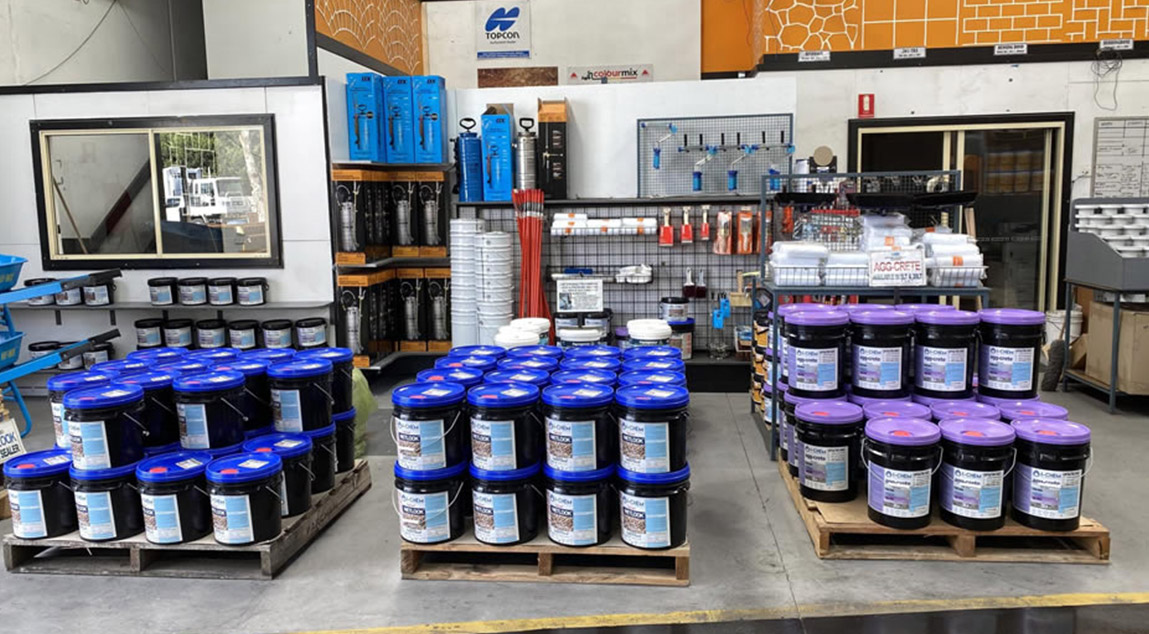Understanding the Role of Exposed Aggregate Retarder in Concrete Works

A lot goes into the process of a successful concrete project. As a trustworthy exposed aggregate retarder, which is also commonly referred to as a concrete surface retarder.
Exposed aggregate concrete provides an aesthetically pleasing and functional finish for various construction and landscaping projects. Put simply, the main goal of this approach is to create a durable surface further enhanced by the beauty of revealed natural aggregates. Overall, this method translates to greater efficiency, uniformity, and control over the finish while surpassing traditional techniques like acid etching or abrasive blasting.
Delve into the nuances of exposed aggregate retarders, their benefits, and the scenarios in which they are most effectively utilised.
What is an Exposed Aggregate Retarder?
An exposed aggregate retarder is a chemical solution applied to freshly poured concrete’s surface. Its primary function is to temporarily halt the surface mortar’s hydration process without affecting the underlying concrete’s curing and strength gain.
This selective retardation allows for the subsequent removal of the surface paste, thereby making way for the embedded aggregates that lie beneath. Unlike full-depth concrete retarders, surface retarders offer precise control over the depth of the aggregate exposure. This is one of the major reasons they’ve become an indispensable tool in creating exposed aggregate finishes.
Exposed Aggregate Concrete – How They Work
Once applied, the retarder acts by penetrating the top layer of the concrete and delaying its set time. This controlled delay and slowed reaction enables the rest of the concrete to cure normally while keeping the surface layer malleable. After the designated waiting period, which is typically between 12 to 24 hours, the retarded surface layer can be easily washed away.
After the necessary time has elapsed, it exposes the aggregate without damaging it or altering its colour. The final result is then a smooth and even finish.
Benefits of Exposed Aggregate Retarder
What are the major benefits of an exposed aggregate retarder? Let’s quickly explore three key areas where these products come in handy.
1. A Uniform and Appealing Finish
One of the most significant advantages of using an exposed aggregate retarder is achieving a finish visually appealing. On the other hand, traditional methods may lead to an uneven finish or even damage the underlying aggregate itself.
Thankfully, retarders are purpose-designed to mitigate these exact issues while helping to create a smooth, uniform surface that enhances the visual appeal of the concrete.
2. Enhanced Durability and Safety
Exposed aggregate surfaces also help with two key functional aspects–slip resistance and durability. As a result, they have become critical for outdoor concrete surfaces like driveways, walkways, and patios.
So, how exactly does the exposed aggregate retarder work here? These products ensure that any aggregates are firmly embedded and evenly distributed, thereby contributing to the concrete’s longevity and safety. Looking to improve your outdoor space with quality home improvement techniques? Check out how to enhance your project with coloured concrete hardener!
3. Greater Control Over Finish
The application of surface retarders allows for an adjustable depth of exposure. This allows contractors and homeowners to customise the look of their concrete surfaces.
Whether the goal is a subtle reveal of fine aggregates or a more dramatic exposure of larger stones, retarders can achieve various visual styles and finishes.
Applications of Exposed Aggregate Retarder
Exposed aggregate retarders can be used in various settings, including residential, commercial, industrial, and public infrastructure projects. Some of the most common applications include:
- Driveways and Parking Areas: Offering aesthetic appeal and durability, exposed aggregate finishes are ideal for high-traffic areas.
- Patios and Pool Decks: The slip-resistant nature of exposed aggregate makes it a safe and attractive choice for outdoor leisure areas.
- Public Walkways and Plazas: For urban landscapes, exposed aggregate concrete provides a practical yet visually appealing surface that withstands heavy foot traffic.
- Architectural Concrete Features: Retarders allow for creative expression in architectural elements, enabling the integration of colour and texture through exposed aggregate.
Whether you need an effective exposed aggregate retarder or a concrete surface hardener, you can find everything right here at Australian Slate Crete Supplies. Explore our range online and order our exposed aggregate supplies in Melbourne today.
What Happens Without an Exposed Aggregate Retarder?
Since we’ve already covered the benefits of exposed aggregate retarders, let’s shift towards what might happen if they are not used. Developing a greater understanding of these potential issues highlights the importance of using a retarder in projects that aim to use exposed aggregate surfaces.
Inconsistent Exposure
Without a retarder, achieving a uniform aggregate exposure can be highly challenging. Manual methods–such as sandblasting or water washing–can lead to uneven removal of the surface paste. Why is this the case?
Without the controlled delay of set time, it will typically appear patchy. Some areas may have too much aggregate exposed, while others may have too little or none at all, detracting from the overall aesthetic appeal.
Greater Risk of Aggregate Damage
The alternative methods for exposing aggregate, including mechanical or abrasive techniques, also carry a higher risk of damaging the aggregates. This damage can result in chipping, cracking, or complete dislodgement of the stones from the concrete matrix.
Not only does this compromise the visual appeal, but it can also affect the concrete’s structural integrity and surface durability. Applying the right retarders adds layer of protection for the surface moving forward.
Increased Labour and Costs
Attempting to achieve an exposed aggregate finish without a retarder often results in significantly more labour. Manual methods are time-consuming and require skilled labour to attempt uniformity in exposure.
Additionally, the potential need for repairs or rework due to inconsistent exposure or aggregate damage can increase project costs regarding materials and labour.
Potential Safety Hazards
Exposed aggregate surfaces are sought after for their slip-resistant qualities. However, improperly exposed aggregate can result in a surface that is too smooth or rough, posing safety hazards.
A surface that is too smooth might become slippery, especially when wet, while an overly rough surface can pose a tripping hazard or make it difficult for mobility-impaired individuals to navigate.
Environmental Impact
Methods such as acid etching or abrasive blasting can have a greater environmental impact than surface retarders. These methods may generate hazardous waste or airborne dust that requires careful handling and disposal, posing environmental and worker health risks. If you would like to learn more about modern design and landscaping concrete, have a read of maintenance tips for exposed aggregate concrete and how you can ensure your project will last.
Want your next concreting project to go as smoothly as possible? We are the go-to source for high-quality concreting tools and equipments for your project. Order online or contact us to speak with an expert!
Features and Benefits of Exposed Aggregate Concrete Retarders
So, now that you know the various benefits of exposed aggregate retarder supplies, the next step is to find an option that best suits your project. Below are some current options available, all of which have distinctive features and benefits. Let’s quickly cover them now:
1. i-Chem Agg-Crete
Features & Benefits:
- Tailored to create exposed aggregate effects on horizontal surfaces.
- Ensures even and uniform exposure, enhancing the aesthetic quality.
- Optimised for ease of use, catering to a broad range of concrete applications.

A lot goes into the process of a successful concrete project. As a trustworthy exposed aggregate retarder, which is also commonly referred to as a concrete surface retarder.
Exposed aggregate concrete provides an aesthetically pleasing and functional finish for various construction and landscaping projects. Put simply, the main goal of this approach is to create a durable surface further enhanced by the beauty of revealed natural aggregates. Overall, this method translates to greater efficiency, uniformity, and control over the finish while surpassing traditional techniques like acid etching or abrasive blasting.
Delve into the nuances of exposed aggregate retarders, their benefits, and the scenarios in which they are most effectively utilised.
What is an Exposed Aggregate Retarder?
An exposed aggregate retarder is a chemical solution applied to freshly poured concrete’s surface. Its primary function is to temporarily halt the surface mortar’s hydration process without affecting the underlying concrete’s curing and strength gain.
This selective retardation allows for the subsequent removal of the surface paste, thereby making way for the embedded aggregates that lie beneath. Unlike full-depth concrete retarders, surface retarders offer precise control over the depth of the aggregate exposure. This is one of the major reasons they’ve become an indispensable tool in creating exposed aggregate finishes.
Exposed Aggregate Concrete – How They Work
Once applied, the retarder acts by penetrating the top layer of the concrete and delaying its set time. This controlled delay and slowed reaction enables the rest of the concrete to cure normally while keeping the surface layer malleable. After the designated waiting period, which is typically between 12 to 24 hours, the retarded surface layer can be easily washed away.
After the necessary time has elapsed, it exposes the aggregate without damaging it or altering its colour. The final result is then a smooth and even finish.
Benefits of Exposed Aggregate Retarder
What are the major benefits of an exposed aggregate retarder? Let’s quickly explore three key areas where these products come in handy.
1. A Uniform and Appealing Finish
One of the most significant advantages of using an exposed aggregate retarder is achieving a finish visually appealing. On the other hand, traditional methods may lead to an uneven finish or even damage the underlying aggregate itself.
Thankfully, retarders are purpose-designed to mitigate these exact issues while helping to create a smooth, uniform surface that enhances the visual appeal of the concrete.
2. Enhanced Durability and Safety
Exposed aggregate surfaces also help with two key functional aspects–slip resistance and durability. As a result, they have become critical for outdoor concrete surfaces like driveways, walkways, and patios.
So, how exactly does the exposed aggregate retarder work here? These products ensure that any aggregates are firmly embedded and evenly distributed, thereby contributing to the concrete’s longevity and safety. Looking to improve your outdoor space with quality home improvement techniques? Check out how to enhance your project with coloured concrete hardener!
3. Greater Control Over Finish
The application of surface retarders allows for an adjustable depth of exposure. This allows contractors and homeowners to customise the look of their concrete surfaces.
Whether the goal is a subtle reveal of fine aggregates or a more dramatic exposure of larger stones, retarders can achieve various visual styles and finishes.
Applications of Exposed Aggregate Retarder
Exposed aggregate retarders can be used in various settings, including residential, commercial, industrial, and public infrastructure projects. Some of the most common applications include:
- Driveways and Parking Areas: Offering aesthetic appeal and durability, exposed aggregate finishes are ideal for high-traffic areas.
- Patios and Pool Decks: The slip-resistant nature of exposed aggregate makes it a safe and attractive choice for outdoor leisure areas.
- Public Walkways and Plazas: For urban landscapes, exposed aggregate concrete provides a practical yet visually appealing surface that withstands heavy foot traffic.
- Architectural Concrete Features: Retarders allow for creative expression in architectural elements, enabling the integration of colour and texture through exposed aggregate.
Whether you need an effective exposed aggregate retarder or a concrete surface hardener, you can find everything right here at Australian Slate Crete Supplies. Explore our range online and order our exposed aggregate supplies in Melbourne today.
What Happens Without an Exposed Aggregate Retarder?
Since we’ve already covered the benefits of exposed aggregate retarders, let’s shift towards what might happen if they are not used. Developing a greater understanding of these potential issues highlights the importance of using a retarder in projects that aim to use exposed aggregate surfaces.
Inconsistent Exposure
Without a retarder, achieving a uniform aggregate exposure can be highly challenging. Manual methods–such as sandblasting or water washing–can lead to uneven removal of the surface paste. Why is this the case?
Without the controlled delay of set time, it will typically appear patchy. Some areas may have too much aggregate exposed, while others may have too little or none at all, detracting from the overall aesthetic appeal.
Greater Risk of Aggregate Damage
The alternative methods for exposing aggregate, including mechanical or abrasive techniques, also carry a higher risk of damaging the aggregates. This damage can result in chipping, cracking, or complete dislodgement of the stones from the concrete matrix.
Not only does this compromise the visual appeal, but it can also affect the concrete’s structural integrity and surface durability. Applying the right retarders adds layer of protection for the surface moving forward.
Increased Labour and Costs
Attempting to achieve an exposed aggregate finish without a retarder often results in significantly more labour. Manual methods are time-consuming and require skilled labour to attempt uniformity in exposure.
Additionally, the potential need for repairs or rework due to inconsistent exposure or aggregate damage can increase project costs regarding materials and labour.
Potential Safety Hazards
Exposed aggregate surfaces are sought after for their slip-resistant qualities. However, improperly exposed aggregate can result in a surface that is too smooth or rough, posing safety hazards.
A surface that is too smooth might become slippery, especially when wet, while an overly rough surface can pose a tripping hazard or make it difficult for mobility-impaired individuals to navigate.
Environmental Impact
Methods such as acid etching or abrasive blasting can have a greater environmental impact than surface retarders. These methods may generate hazardous waste or airborne dust that requires careful handling and disposal, posing environmental and worker health risks. If you would like to learn more about modern design and landscaping concrete, have a read of maintenance tips for exposed aggregate concrete and how you can ensure your project will last.
Want your next concreting project to go as smoothly as possible? We are the go-to source for high-quality concreting tools and equipments for your project. Order online or contact us to speak with an expert!
Features and Benefits of Exposed Aggregate Concrete Retarders
So, now that you know the various benefits of exposed aggregate retarder supplies, the next step is to find an option that best suits your project. Below are some current options available, all of which have distinctive features and benefits. Let’s quickly cover them now:
1. i-Chem Agg-Crete
Features & Benefits:
- Tailored to create exposed aggregate effects on horizontal surfaces.
- Ensures even and uniform exposure, enhancing the aesthetic quality.
- Optimised for ease of use, catering to a broad range of concrete applications.

4. Sika Rugasol ® C
Features & Benefits:
- Reliable and uniform results in creating exposed aggregate finishes.
- Compatible with a wide range of concrete mixes, offering application flexibility.
- The red colour facilitates visibility during application, promoting uniformity across the treated area.
Concreting Tools in Melbourne – Quality Exposed Aggregate Retarder Products
Whenever you need exposed aggregate retarders for concrete surfaces, Australian Slate Crete Supplies is the only supplier you need to rely on. Whether you’re looking for concreate sealers, hand tools, stencils, concrete hardeners, or acid and cleaning chemicals, we have over 25 years of experience distributing leading building supplies that is quality controlled.
For more information on our exposed aggregate supplies available in Melbourne or any of our other concreting tools and accessories, don’t hesitate to give our friendly customer service team a call on 03 9408 7722 today.
All of our products are developed and manufactured in-house by concrete, meaning you can only expect the highest quality exposed aggregate supplies.
-
 February 4, 2022Sandstone Concrete Stencil
February 4, 2022Sandstone Concrete StencilDo you want to add a touch of luxury and elegance to your concrete projects? If so, then consider using sandstone concrete stencils!
Read More -
 February 4, 2022Gloss Brick Sealer
February 4, 2022Gloss Brick SealerGloss brick sealer is a wonderful material for adding a brilliant shine to your brick slip wall feature.
Read More -
 February 4, 2022Bluestone Concrete Sealer
February 4, 2022Bluestone Concrete SealerIn a broad sense, the term “bluestone” is sometimes used to refer to a variety of stones. It’s a marketing term rather than a geological one.
Read More
